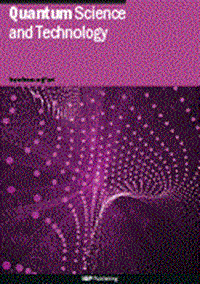几乎与设备无关的校准超出了伯恩规则:贝尔测试串音检测
IF 5
2区 物理与天体物理
Q1 PHYSICS, MULTIDISCIPLINARY
引用次数: 0
摘要
在量子信息中,设备无关(DI)协议为信息处理任务提供了一种新的方法,对所使用的设备进行了最小的假设。通常,由于这些协议直接从有意义的贝尔测试中收集的数据中得出结论,因此无信号条件,甚至通常是局部测量的Born规则,都被视为协议的前提。在这里,我们将演示如何在(几乎)DI设置中测试这些前提,即直接从原始数据中使用最少的假设。特别是,对于IBM的量子计算云服务,我们实现了基于预测的比率协议,以表征量子位在本地和独立访问的程度。更准确地说,通过在这些系统上进行各种clauser - horn - shimony - holt型实验,并对收集到的数据进行严格的假设检验,我们提供了令人信服的证据,表明其中一些量子位存在测量串扰,即它们的测量统计量受到选择另一个量子位的测量基础的影响。与标准的随机基准测试不同,我们的方法不依赖于门无关的马尔可夫噪声等假设。此外,尽管实验试验的数量相对较少,但在某些情况下也可以确定“信号传导”的方向。因此,我们的方法可以作为对量子计算设备的本地寻址能力进行基准测试的补充工具。本文章由计算机程序翻译,如有差异,请以英文原文为准。
Almost device-independent calibration beyond Born’s rule: Bell tests for cross-talk detection
In quantum information, device-independent (DI) protocols offer a new approach to information processing tasks, making minimal assumptions about the devices used. Typically, since these protocols draw conclusions directly from the data collected in a meaningful Bell test, the no-signaling conditions, and often even Born’s rule for local measurements, are taken as premises of the protocol. Here, we demonstrate how to test such premises in an (almost) DI setting, i.e. directly from the raw data and with minimal assumptions. In particular, for IBM’s quantum computing cloud services, we implement the prediction-based ratio protocol to characterize how well the qubits can be accessed locally and independently. More precisely, by performing a variety of Clauser–Horne–Shimony–Holt-type experiments on these systems and carrying out rigorous hypothesis tests on the collected data, we provide compelling evidence showing that some of these qubits suffer from measurement cross-talks, i.e. their measurement statistics are affected by the choice of measurement bases on another qubit. Unlike standard randomized benchmarking, our approach does not rely on assumptions such as gate-independent Markovian noise. Moreover, despite the relatively small number of experimental trials, the direction of ‘signaling’ may also be identified in some cases. Our approach thus serves as a complementary tool for benchmarking the local addressability of quantum computing devices.
求助全文
通过发布文献求助,成功后即可免费获取论文全文。
去求助
来源期刊

Quantum Science and Technology
Materials Science-Materials Science (miscellaneous)
CiteScore
11.20
自引率
3.00%
发文量
133
期刊介绍:
Driven by advances in technology and experimental capability, the last decade has seen the emergence of quantum technology: a new praxis for controlling the quantum world. It is now possible to engineer complex, multi-component systems that merge the once distinct fields of quantum optics and condensed matter physics.
Quantum Science and Technology is a new multidisciplinary, electronic-only journal, devoted to publishing research of the highest quality and impact covering theoretical and experimental advances in the fundamental science and application of all quantum-enabled technologies.
 求助内容:
求助内容: 应助结果提醒方式:
应助结果提醒方式:


